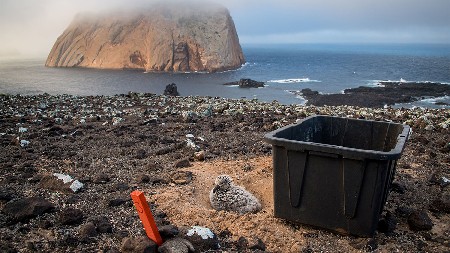Black-footed and Laysan Albatross are among the most spectacular seabirds. With 3.35 metre (11-foot) wingspans, they ride ocean winds for hours at a time and hardly ever need to flap their wings. Like many seabirds, they can drink saltwater. And they have long lifespans with some exceeding 50 years (the oldest known is called Wisdom, a 65-year old Laysan that was first tagged in 1956 and returns to Midway Island, her birthplace every year.
As adults, they grow to a weight of about 3 kilograms (6.6 pounds). But trying to weigh them is nearly impossible because they rarely on land, alighting only when breeding and nursing the single chick they produce annually. Albatross mostly mate for life. They nurse their young chick feeding it fish and squid brought back from long foraging expeditions by either mater. The chick takes a long time to mature with first flight as late as 10 months after hatching. But once aloft the young albatross do not return to their birthplace, or any land for that matter, until sexual maturity, between the ages of 5 and 10. They are either aloft or floating on the ocean surface, the only time they are subject to predation.
In our relationship with albatross in the past, humans killed them for their feathers and down. But today, the birds are a protected species. And they have to be because climate change and sea-level rise are major threats, particularly the latter because the Pacific Ocean islands where they breed are low-lying and in danger of inundation.
The Midway Islands and neighbouring Kure Atoll, the most distant members of the Hawaiian Islands chain, are home to 95% of Laysan and an almost equal percentage of Black-footed Albatross. With the average elevation of these around 3.2 metres (about 10.5 feet) above sea level, an anticipated 0.5 to 1.5-metre rise by 2100, combined with storm surges could effectively destroy these birds’ habitat. In 2011, a tsunami was responsible for wiping out 30,000 nests.
That’s why conservationists decided to start preparing a protected reserve on Guadalupe, a small island located off the coast of Baja California in Mexico. The work has been ongoing for the past 20 years eliminating any predator threats (feral cats and rats) and turning what was a barren rock into a more lush landscape where albatross and other threatened seabirds can find a haven.
By transporting eggs and chicks to Guadalupe, it is hoped that these new young birds once mature will in 5 to 10 years return to nest just as they have done at Midway and Kure Atoll.
To nesting area is fenced-off for both species to establish themselves. It is well above sea level and will not be threatened by rising ocean waters and storm surges for the foreseeable future.
To establish the new colony, researchers had to incubate the translocated eggs, and hand-raise the month-old chicks. Such translocations are difficult to do with threatened wildlife and have rarely been accomplished with seabirds. But by choosing the albatross first, the likeliness of success is considered much greater because the species takes to fostering well and tolerates human presence.
















